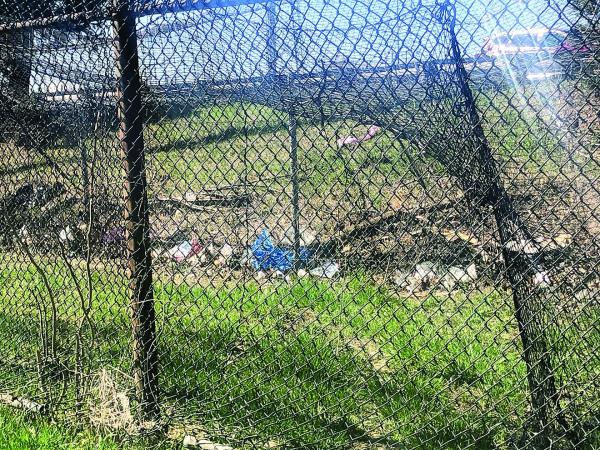April 22, 2021

Debris litters fenced-off space near Expressway. Bill Walczak photo
Last week’s column about the lack of maintenance of the state’s property alongside the Southeast Expressway and the MBTA tracks received quite a response. The trash and graffiti were certainly noticed by residents, and there were calls by readers to organize clean ups and also to demand that the state maintain its property.
The most intriguing response came from Savin Hill’s Liz MacNeil. “I have been thinking trees,” she said. “The noise and pollution of the expressway, commuter trains, and Red Line have helped steer my thoughts that way. At the moment, we seem to be moving backwards. Trees are being sacrificed to new construction, and new ones, even if/when they are being planted, can’t compensate for the carbon removal, pollution reduction, and summer cooling effects of the mature trees they replace.
The intersection of the above and your article is the idea that there need to be trees planted along the side of the expressway wherever possible, such as along the edge of McConnell park.”
Of course! This is a great idea.
Tree planting has become a goal of many cities, including Boston, over the past 20 years. In 2008, Mayor Tom Menino announced that Boston would plant 100,000 trees by 2020, thereby expanding Boston’s tree canopy by 20 percent. The same year, New York City set a goal of planting a million trees. While New York met its goal, Boston failed miserably. When Menino announced his 2008 plan, Boston’s tree canopy was stated as 29 percent. When then-Mayor Walsh announced his Urban Forest Plan last year, the canopy was given as 27 percent.
Why is this important? Climate change and health. Trees soak up carbon emissions and curb energy use, reducing what is called the urban heat island and preventing extreme heat conditions in summer.
On the issue of health, a US Environmental Protection Agency EnviroAtlas Fact Sheet states the following:
“Harmful air pollutants such as airborne particles, nitrogen dioxide, and carbon monoxide are found in high concentrations along busy roadways. Elevated levels of these pollutants, relative to community averages, can persist as much as 300 meters or more from the road edge. Tree cover near busy roadways may act as a buffer from these pollutants, helping to reduce their concentrations…
“When compared with the rest of the population, people who live, work, and go to school near roads are at a greater risk for adverse health effects associated with near-road air pollution, such as respiratory and cardiovascular symptoms, poor birth outcomes, and premature mortality…
“Tree cover adjacent to busy roadways has been shown to alter concentrations of ultrafine particles and other hazardous air pollutants emitted by traffic… Studies show that the tree canopy is capable of filtering air pollutants and diverting the polluted airstream upwards and laterally, where it can mix with cleaner air and become diluted.”
Planting trees along the Southeast Expressway, the major highway entering Boston, will not only extend the tree canopy, but it will also reduce air, noise, and visual pollution for the neighborhoods that endure the burden of suburban transit into the city. And better yet, much of the land on which the trees can be planted is public land.
This is not a new idea. Dating back decades. dozens of states and cities across the nation have planted trees adjacent to interstate highways. When I’m traveling to New York City, my GPS often takes me via the Merritt Parkway in Connecticut, built between 1934 and 1940, which literally runs through a linear forest. Nearby, Cranston, Rhode Island, in 2014 announced a plan to plant buffer trees along Route 95 along a section of the municipality, evergreens “planted to serve as a noise and visual buffer between the interstate and the houses,” according to a July 15, 2014 article in the Providence Journal.
This is a no-brainer. Last October, City Hall issued a request for proposals for an Urban Forestry plan with a budget of $500,000, and the city has $1.7 million meant for trees this year. Why Boston has not heretofore bothered to plant buffer trees along the Southeast Expressway is a mystery. As our governments clean up the mess along the Expressway, it should also be planting trees.
That proposition will be an agenda item for the May 3 meeting of the Columbia-Savin Hill Civic Association, and it should be raised by other civic associations along the Expressway. It’s time to get this idea into the city’s and state’s budgets.



